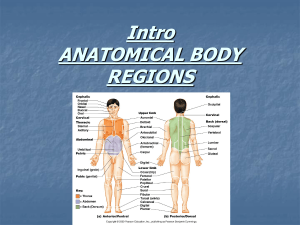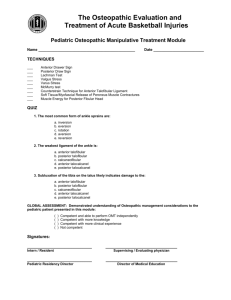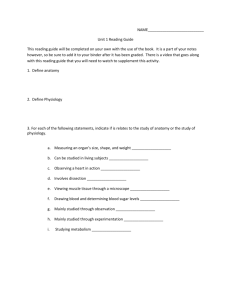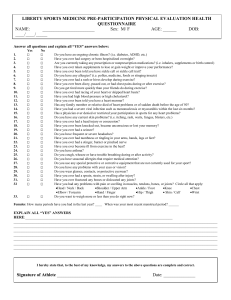OMT for Extremity Complaints Handouts
advertisement
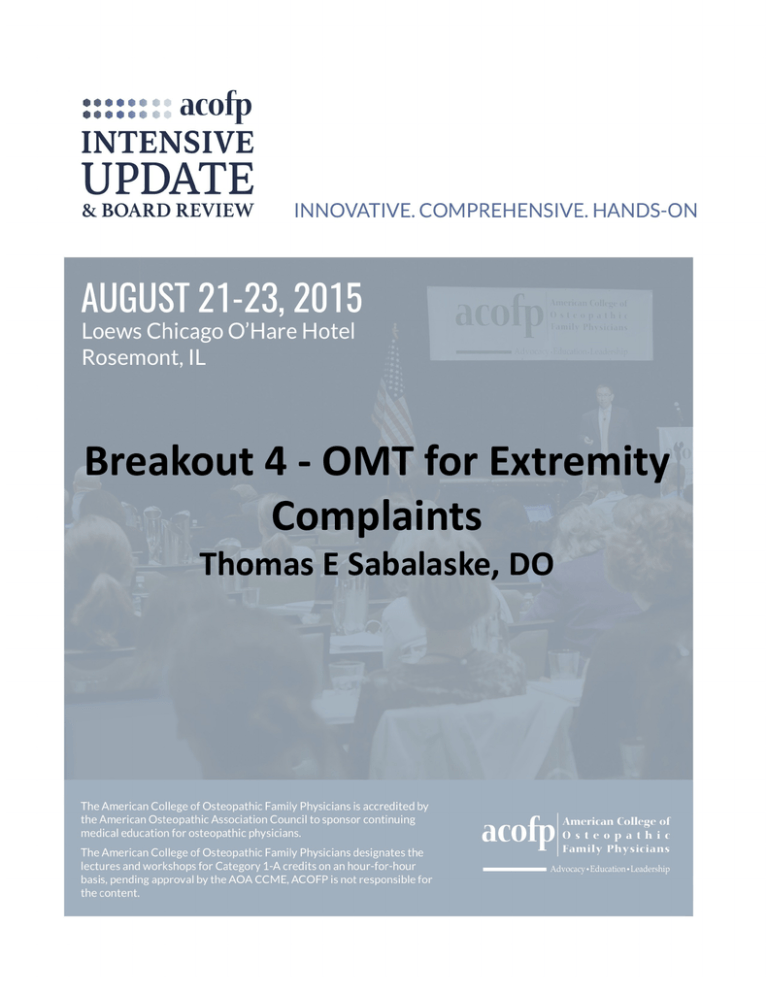
Breakout 4 - OMT for Extremity Complaints Thomas E Sabalaske, DO 8/6/2015 OMT of the Extremities Board Review Thomas E. Sabalaske DO www.doctorsab.com AOCFP Intensive Update and Board Review August 2015 Objectives Brief anatomy review of the extremity articulations and tissues Review diagnosis and treatment of some of the more common conditions seen in family medicine and on the practical Establish principals for treating any dysfunction that is presented on the boards 1 8/6/2015 Remember for the Practical RELAX!!!! If you are having difficulty, think of the anatomy involved and that can lead you to a solution using the available muscles, ligaments, fascia etc. Don’t be afraid to mention all treatment options Recheck the dysfunction Shoulder Anatomy Three true joints: Glenohumeral Sternoclavicuar – sellar joint Acromioclavicular – plane joint One pseudo joint: Scapulothoracic 2 8/6/2015 Shoulder Anatomy Rotator cuff tendons (SITS): Supraspinatus Infraspinatus Teres minor Subscapularis Major function is to stabilize the glenohumeral joint and enable external rotation 3 8/6/2015 Spencer Technique Good for adhesive capsulitis Stretch the muscle group to test its range of motion, use muscle energy to work the muscle group to achieve post isometric relaxation Spencer Stages 1. 2. 3. 4. 5. 6. 7. 8. Extension Flexion Circumduction with compression Circumduction with distraction Abduction (with int/ext rotation) Another internal rotator Massage relaxer/lymph pump Retest – as ALWAYS 4 8/6/2015 Spencer Mnemonic Elephants – Extension Fly - Flexion Constantly - circumduction To – traction (and circumduction) Annoy - abduction Intoxicated – internal rotation People - pump Shoulder Counterstrain Technique You can always attempt to counterstrain any tender points either anterior or posterior in the shoulder. While monitoring the point, simply approximate the origin and insertion of the muscle/tendon being treated. This works well for tendonitis. * 5 8/6/2015 Shoulder Muscle Energy Most asymmetries of motion and impingement syndromes of the shoulder are amenable to muscle energy to facilitate a better balanced position. Teaching home exercises enhances the benefit. Elbow Anatomy One true joint – ulno-humeral (range of motion flexion – 160 deg Extension – 0 deg.) Two accessory joints 1. 2. Radiohumeral Proximal radioulnar 6 8/6/2015 Nursemaid’s Elbow Subluxation of the radial head To reduce, place thumb over radial head, then supinate and flex the elbow affected (quickly before the child has time to resist). Another effective option is to pronate the wrist and flex and extend the elbow 7 8/6/2015 Anterior Radial Head Diagnose with decreased posterior motion Treatment – HVLA – Pronate pt’s wrist while flexing at elbow, grab radial head with a few fingers, and encourage posterior motion while hyper-flexing the elbow. Posterior Radial Head Diagnose with decreased anterior radial head motion Treatment – Contact radial head with fingers, encouraging anterior motion while hyperextending the elbow joint. 8 8/6/2015 Decreased pronation/supination Diagnose as above, often found in combination with other dysfunctions Treat with direct muscle energy in a “shaking hands with patient” position Epicondylitis Diagnose with point tenderness on either epicondyle and associated muscle use pain (lateral – posterior forearm muscles; medial – anterior) Treatment – first treat all surrounding dysfunctions, then counterstrain (extend the elbow and pronate for medial; or supinate for lateral) and then educate * 9 8/6/2015 Carpal Tunnel Entrapment of the distal branches of the median nerve Gives parasthesias along first 3 ½ fingers and weak thumb abduction TESTS Tinel’s tap Phalens/reverse Phalens test (more accurate) 10 8/6/2015 11 8/6/2015 Carpal Tunnel Treatment Remove harmful behaviors, habits and ergonomics Look for somatic dysfunction in upper thoracics, cervicals, and entire upper extremity. Muscle energy to wrist Flexor retinaculum stretch Home stretching/bracing Metacarpal dysfunction Diagnosis pain and decreased motion of one or more of the metacarpals Wiggle it (just a little bit) – articulatory technique where you translate the metacarpal ant/post with the neighboring metacarpals 12 8/6/2015 Fingers Gap and gently rotate any stiff or dysfunctional phalanges * Hip Joint Anatomy Femoroacetabular joint – ball and socket synovial joint Primary flexor – iliopsoas Primary extensor – gluteus maximus Held in place by 4 ligaments and surrounding musculature 13 8/6/2015 14 8/6/2015 Functional Hip Stacking Technique Patient supine Palpate anterior hip capsule area Take the leg indirectly – away from all barriers (flexion/extension, ab/adduction, internal external rotation, compression/distraction) Hold until release is felt, then slowly return Lateral Trochanteric Counterstrain Patient prone or supine Palpate tender point Abduct the leg and adjust with mild flex/ext or rotation to maximally decrease the tenderness of the point Hold for 90 seconds, slowly return 15 8/6/2015 Piriformis Counterstrain Patient prone Monitor tender point Flex patient’s hip and knee to 90 degrees, abduct and externally rotate to maximally decrease tenderness Hold for 90 and slowly return Hip Musculature Don’t forget to simply use muscle energy to address any abnormal tension in any of the muscles of the hip to enhance function * 16 8/6/2015 Knee Anatomy Three Major Joints 1. Tibiofemoral joint 2. Patellofemoral joint 3. Tibiofibular joint – synovial joint important for pronation/supination of feet Major Knee Ligaments Anterior cruciate – prevents anterior tibial translation Posterior cruciate – prevents posterior translation Medial collateral (tibial collateral) Lateral collateral (fibular collateral) 17 8/6/2015 Tibia on Femur dysfunction Treats abduction/adduction dysfunctions as well as torsions of tibia on femur Patient supine, physician contacts above and below knee and directly applies pressure through soft tissue barriers in rotation and varus/valgus 18 8/6/2015 Counterstrain Patellar Tenderpoints Patient supine Foot/tibia internally rotated Physician grasps quad above knee and provides an inferior force, while palpating tenderpoint with other hand Anterior Fibular Head HVLA Patient supine with pillow under knee Physician internally rotates patient’s foot/ankle Thrusts fibular head posteriorly while continuing to internally rotate ankle 19 8/6/2015 Posterior Fibular Head HVLA Patient supine with hip and knee flexed Physician externally rotates ankle/foot with other hand in popliteal fossa Knee is flexed while applying anterior pressure on fibular head * Ankle Anatomy 1 major joint Talocrural (Tibiotalar) – hinge joint connecting talus to tibia/fibula Many minor joints and ligaments important for movement and shock absorption. Anterior talofibular ligament most commonly torn (always tears first) 20 8/6/2015 HVLA Anterior Tibia on Talus Tibia resists posterior translation, ankle prefers dorsiflexion Patient supine, physician at foot of table Physician’s grasps patient’s heel and applies traction Corrective force with other hand posteriorly through distal tibia 21 8/6/2015 HVLA Posterior Tibia on Talus Tibia resists anterior translation, ankle in plantarflexion Patient supine, physician at end of table Physician grasps foot with both hands, applies traction, dorsiflexion and mild eversion, and gives a gentle tug * Foot Anatomy Remember bones involved Plantar fascia – medial calcaneus extends out to phalanges Longitudinal arch (medial and lateral) Transverse arch 22 8/6/2015 23 8/6/2015 Foot conditions Pes planus – flat feet Hallux valgus – bunion Hammer toes – plantarflexion pip joints Plantar faciitis Midfoot Thrust (Hiss Whip) Patient prone, physician stands along side of dysfunction Physicians grasps the foot with thumbs crossed over dysfunctional bone, and applies downward thrust while inducing a whip-like motion of the foot and ankle 24 8/6/2015 Metatarsal Articulation Patient supine, physician grasps foot and stabilizes one metatarsal while gently moving the adjacent metatarsal to increase mobility 25
